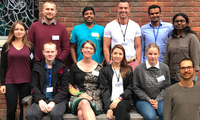Mucins in Infection and Cancer
Short description
The body's mucosal surfaces are protected by a mucus layer that is constantly being renewed, thus "washing away" unwanted guests. The mucus layer is mainly comprised by large glycoproteins called mucins. The goal of Sara Lindén's research group is to develop methods to improve the mucins' defense capabilities and thereby eliminate chronic infections and to shorten the course of disease for other infections. The mechanisms for the functioning of the mucin-based defense system are likely to be similar for many of the disease-producing organisms that infect mucous membranes. By extension, it is therefore likely that treatment strategies based on the body's own mucin defense could be effective both in emerging pandemics such as prophylactic treatment and in treating infections that have been shown to be resistant to antibiotics.
The mucosal tissues of the gastrointestinal, respiratory, reproductive and urinary tracts and the surface of the eye present an enormous surface area to the exterior environment in mammals, and in fish the skin further adds to this area. Mucosal tissues represent the site of infection or a route of access for the majority of bacteria that cause diseases. To protect the epithelial cells, the mucosal surfaces are covered by a layer of secreted mucins that have a decoy/cleaning function, and underneath the mucus layer the cell-surface mucins are a dominant feature of the apical surface of mucosal epithelial cells. The cell surface mucins provide a barrier and signaling function and are involved in tumour metastasis as well as regulation of cell proliferation. In infection, precancerous lesions and cancer, the expression and spatial distribution of mucins change. Each mucin carries around 100 different oligosaccharide structures, and some of these change rapidly in response to infection in a way that alters the bacterial adhesion targets. Thus, the mucin barrier is dynamic and responsive and is likely to play a major role during infection and malignant transformation.
We investigate the role of mucins during host defense against bacteria, as well as the biological function of changes in mucosal mucin expression and glycosylation associated with disease. Currently it is not known which of the changes that are beneficial for the host or the pathogen, or if they take part in malignant processes or merely accompany them, and furthering the knowledge in this area may lead to novel ways of treating disease. We are interested in the role of mucus in veterinary (salmonids (fish) and pigs) and human medicine, as mucins and mucus have potential both to aid in earlier healing of infection and healing of chronic infections and to limit spreading of infection between individuals. Use of antibiotics in veterinary medicine adds to the spreading of antibiotic resistant bacteria and genes into our environment, when antibiotics resistance perhaps is the most serious challenge facing medicine today, threatening to throw us back into the pre-penicillin era when infections now considered trivial killed you. Developing methods to treat infection without antibiotics will increase animal welfare and food production efficiency and can save human lives.

Sara Lindén
Principal Investigator
Affiliation:
Department of Medical Biochemistry and Cell Biology,
Institute of Biomedicine

Group members
Mattias Erhardsson
Licinia Santos
Kristina Thomsson Hulthe
Sinan Sharba
John Benkander
Kyung Min Lee